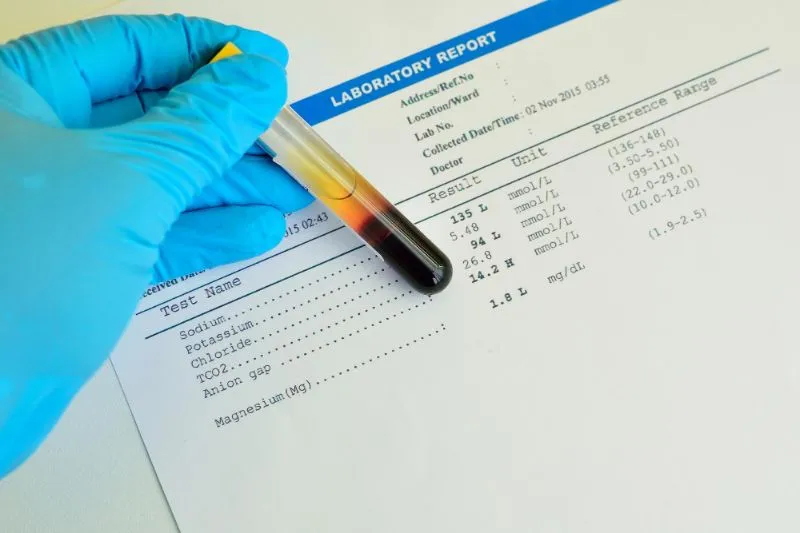The Anion Gap blood test emerges as an essential metric, providing valuable insights into the complex metabolic processes within the body. This comprehensive blog is dedicated to unraveling the complexities associated with the Anion Gap blood test. It spans from the fundamental definition of the Anion Gap, delving into its underlying principles, to exploring its wide-ranging diagnostic applications and practical implications. Beyond its numerical value, the Anion Gap serves as a key indicator in diagnosing various medical conditions, providing healthcare professionals with valuable insights into the intricacies of the body's acid-base equilibrium and metabolic state.
Introduction to Anion Gap: A Vital Metric in Blood Tests
To comprehend the critical role of the Anion Gap in blood tests, it's essential to delve into its fundamental function. In simple terms, the Anion Gap, also known as serum anion gap (or agap blood test), is a numerical calculated measure derived from analyzing various ion concentrations in the bloodstream. This metric holds paramount importance for healthcare providers as it offers insightful perspectives on two crucial aspects of the body: its acid-base equilibrium and metabolic condition. The Anion Gap blood test serves as a means to assess the pH balance of the blood, determining whether it is excessively acidic or not acidic enough. This assessment relies on the results of an electrolyte panel, which measures electrically charged minerals in the body, like sodium, potassium, and bicarbonate, crucial for regulating blood's acid-base balance.
The anion gap specifically gauges the difference—or gap—between negatively and positively charged electrolytes in the blood. Elevated anion gap levels indicate increased blood acidity, while low levels suggest insufficient acidity. Both extremes may signify a serious underlying disorder requiring attention. Practically, the Anion Gap emerges as a potent diagnostic tool for healthcare professionals, providing a glimpse into a patient's physiological status. By examining the results of the anion gap blood test, doctors can glean valuable insights into the body's acid-base stability and overall metabolic well-being.
Anion Gap Defined: Breaking Down the Basics
At its core, the Anion Gap is determined through a precise calculation involving the subtraction of chloride and bicarbonate ion concentrations from sodium ion concentration. This calculation serves as a fundamental cornerstone, shedding light on the presence of unmeasured ions in the blood.
Delving deeper into the process, Sodium, Chloride, and bicarbonate ions play pivotal roles in the complex symphony of blood chemistry. The Anion Gap, shaped by the difference between positively charged sodium ions and negatively charged chloride and bicarbonate ions, encapsulates a numerical representation of this ion balance. Specifically, the anion gap represents the variance between primary measured cations (sodium Na+ and potassium K+) and primary measured anions (chloride Cl- and bicarbonate HCO3-) in serum. The equation itself functions as an estimate to gauge unmeasurable anions in the blood, with the commonly used formula being:
Serum anion gap = (Na + K) - (Cl + HCO3).
It's important to acknowledge that some protocols may exclude potassium from the equation since sodium is the more dominant cation. Breaking down this fundamental equation provides individuals with an understanding of how the Anion Gap operates as an indicator. The subtraction of specific ions underscores the significance of balance and reveals any deviations, signaling the potential presence of unmeasured ions. Identifying these unmeasured ions through the Anion Gap prompts further investigation, as their detection may indicate underlying health conditions or metabolic disturbances.

Understanding Anion Gap Blood Test Results: Deciphering the Numbers for Better Health Insights
The Anion Gap plays a key role in helping healthcare professionals identify potential health issues. To make sense of the results, let's break it down. The Anion Gap is calculated by finding the difference between positively charged ions (sodium Na+ and potassium K+) and negatively charged ions (chloride Cl- and bicarbonate HCO3-) in the blood. The normal range is around 16 ± 4 mEq/L (including potassium) or 12 ± 4 mEq/L (excluding potassium). However, it's crucial to note that specific laboratories may have slight variations in their reference ranges, so it's advisable to refer to the range provided by the conducting laboratory. Values outside this range may suggest conditions like lactic acidosis or diabetic ketoacidosis, indicating an imbalance in the body's acid-base balance. Conversely, a low Anion Gap may point to conditions such as hypoalbuminemia linked to decreased albumin in the blood, which can be associated with liver or kidney disorders, malnutrition, or inflammatory conditions.
Various medical conditions can affect Anion Gap results. A high Anion Gap may indicate acidosis due to factors like dehydration, diarrhea, excessive exercise, kidney diseases, diabetes (diabetic ketoacidosis), certain medicines, or poisons. A low Anion Gap, though rare, may signal alkalosis, often associated with low albumin levels due to insufficient protein intake, kidney problems, liver disease, heart disease, or certain cancers.
The Anion Gap test provides insights into the acid-base balance of the blood, reflecting overall bodily health. Given the range of normal results and potential causes of abnormalities, discussing results with a healthcare provider is crucial for interpretation and determining if additional tests are needed. To ensure accuracy, ruling out laboratory errors is essential. If results are questionable, reassessing electrolytes is recommended, as collection errors can impact ion measurements.
For a high Anion Gap, additional tests such as urine ketones, serum ketones (beta-hydroxybutyrate), serum lactic acid, urine drug screen, serum drug screen, salicylate level, and creatinine kinase level may be performed to diagnose the cause of anion gap acidosis. The urine anion gap, whether positive or negative, is useful when the causes of normal anion gap acidosis are unclear, with a positive urine anion gap observed in conditions like type 1 and type 2 renal tubular acidosis versus almost every other cause of normal anion gap acidosis (e.g., diarrhea).
This nuanced interpretation transforms the Anion Gap from a numerical output into a diagnostic tool, offering valuable insights into a patient's physiological state. By considering an individual's health context, clinicians can make informed decisions about further testing, diagnosis, and developing targeted treatment plans.
Diagnostic Applications: How Anion Gap Helps Identify Health Issues
The Anion Gap is a dynamic metric reflecting the equilibrium between positively and negatively charged ions in the bloodstream. Elevated or low Anion Gap values can signal underlying health conditions, rendering it an invaluable diagnostic tool for healthcare providers.
A crucial diagnostic application of the Anion Gap lies in identifying renal dysfunction. Impaired kidney function disrupts the normal acid excretion process, resulting in an accumulation and, consequently, an elevated Anion Gap. This insight allows healthcare providers to pinpoint the renal component of metabolic disturbances, facilitating tailored interventions to address kidney-related issues.
Metabolic acidosis stemming from conditions such as diabetes or kidney failure significantly contributes to an elevated Anion Gap. In diabetes, excessive ketone production can create an acidic environment, while kidney failure may impede the body's ability to eliminate acid, leading to an accumulation reflected in an elevated Anion Gap. This insight proves essential for healthcare professionals, aiding in identifying specific origins of metabolic disturbances.
Furthermore, the Anion Gap proves to be a reliable marker for toxic ingestions. Ingesting toxic amounts of substances like methanol, ethylene glycol, or aspirin can contribute to metabolic disturbances reflected in an altered Anion Gap. Recognizing these toxicological origins enables prompt and targeted interventions, including detoxification measures or antidotal therapies, safeguarding patients from potential harm.
By exploring these diagnostic applications, healthcare providers can harness the Anion Gap as a comprehensive tool in their diagnostic arsenal. It not only aids in identifying specific health issues but also contributes to a more nuanced understanding of underlying physiological imbalances. Essentially, the Anion Gap emerges as a diagnostic ally, guiding healthcare providers toward accurate assessments and enabling tailored interventions that enhance patient care and outcomes.
Practical Aspects: What to Expect During an Anion Gap Blood Test
Before the Anion Gap blood test, minimal preparation is typically required. It is advisable to inform healthcare providers about any medications being taken, as certain drugs might influence test results. Fasting is generally not necessary for an Anion Gap test, making it a relatively straightforward procedure for individuals. The actual blood draw is a standard and routine procedure conducted by skilled healthcare professionals. Individuals can expect a tourniquet to be applied to the upper arm to make veins more visible and accessible. A small needle is then used to draw a blood sample, usually from a vein in the arm. While some people may experience mild discomfort, the process is generally quick and well-tolerated. After the blood draw, individuals may resume normal activities immediately. Discussing the results thoroughly with the healthcare provider is important, as they can provide valuable insights into one's health and guide any necessary next steps or interventions.
Closing Thoughts: Empowering Yourself Through Anion Gap Knowledge
In conclusion, the Anion Gap blood test serves as a pivotal metric in clinical analysis, providing crucial insights into the body's metabolic processes. From understanding its calculated nature to decoding test results and recognizing its role in a broader diagnostic context, the Anion Gap emerges as a multifaceted tool. Collaborating with healthcare professionals is crucial for accurate interpretation and the formulation of tailored action plans based on individual health circumstances. Always consult with your healthcare provider for precise guidance and optimal health outcomes. In the realm of healthcare, collaboration with healthcare providers is the cornerstone for achieving optimal health outcomes. For comprehensive Anion Gap testing, trust Cura4U - providing affordable tests from reputable labs like Quest Diagnostics and Bio-Reference. Schedule your tests with Cura4U, and leverage online doctor consultation services for a proactive approach to your health. Remember, your healthcare provider remains your best guide for personalized advice and test result interpretation. Empower yourself with Cura4U's reliable services.
Our clinical experts continually monitor the health and medical content posted on CURA4U, and we update our blogs and articles when new information becomes available. Last reviewed by Dr. Saad Zia on Jan 2nd, 2023.
References
Anion Gap Blood Test: MedlinePlus Medical Test- https://medlineplus.gov/lab-tests/anion-gap-blood-test/#:~:text=The%20anion%20gap%20measures%20the,blood%20isn't%20acidic%20enough.
Anion Gap: Reference Range, Interpretation, Collection and Panels (medscape.com)- https://emedicine.medscape.com/article/2087291-overview
Biochemistry, Anion Gap - StatPearls - NCBI Bookshelf (nih.gov)- https://www.ncbi.nlm.nih.gov/books/NBK539757/
Serum anion gap: its uses and limitations in clinical medicine - PubMed (nih.gov)- https://pubmed.ncbi.nlm.nih.gov/17699401/
UpToDate- https://www.uptodate.com/contents/serum-anion-gap-in-conditions-other-than-metabolic-acidosis











